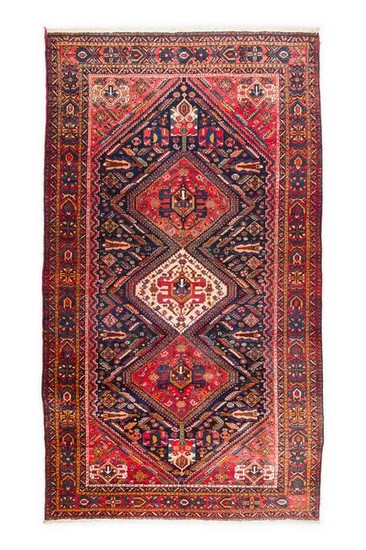Afshary Rug 300 x 172 cm
Afshary 16157
Carpet No(Type N Reference):Â 16157
Origin (State, Province):Â South Persia
Size:Â 300 X 172 CM from sh.sameyeh Oriental carpet catalogue page No.227
Age:Â 2nd quarter of 20th century
Knots. 5 x 5 = 25 knots per sq cm
Condition. Excellent.
Category:Â South Persia
Description of Design and History:
Antique Afshar Rugs – Produced by nomads and villagers in southeastern Iran in the cities of Shiraz, Kerman and Yazd, these antique Persian rugs are some of the few that merge nomadic and village techniques.
The name Afshar derives from the tribe who designs and creates these rugs (also known as the Avsar). They came to Persia and Turkey by way of Iran as part of the Ohguz Turkmen Confederation, which includes 24 other tribes. In the 16th century, Ohguz was more of a principality, rather than a kingdom. The language is still well-preserved and spoken today by people whose ancestors originated from this tribe. Weaving has always been a major part of the artistic creativity of this tribe, and it is not likely to diminish at any time as it is traditionally taught from one generation to the next.
Afshar rugs are similar to antique Caucasian rugs in their rug colors and styles. Using geometric patterns, medallions with diamond patterns and pomegranate vases. Common colors include crimson, saffron gold, ivory, burnt orange and sienna. The design and colors used in Afshar rugs are reflective of the influences from outside regions making these highly stylized and unique rugs.
Afshar rugs are quite distinguishable. Classic features of these antique rugs can include three pendants at either of the two ends (mostly in Sirjan designs), multiple diamond patterns (the number of diamonds can vary within a motif) and the tribal border, which is typical of all rugs made by this tribe. Another very noticeable feature is the medium ribbed back, which is a classic trait. Many antique rugs by this tribe can be found in homes worldwide, today. Some of them are well-preserved and retain their colors quite nicely.
All natural dyes are paramount for the carpet to have more than just decorative value. Beyond that, various dyers had varying levels of skill and invested different lengths of time in dyeing the yarns. The “quality of color”–its radiance and level of nuance within each color–is centrally important. Certain rare colors such as Tyrian purple, saffron yellow, cochineal rose and greens add to the carpet’s value
Condition Report: The absence of a condition report does not imply that the lot is in perfect condition. Please carefully read our terms of sale, shipping pick up & payment information. We are happy and willing to answer questions about any of our lots as well as to send additional images. It is the responsibility of the bidder to pose any questions BEFORE bidding. Please email us for a shipping quote if needed. All sales are final.
View it on
Estimate
Time, Location
Auction House
Afshary 16157
Carpet No(Type N Reference):Â 16157
Origin (State, Province):Â South Persia
Size:Â 300 X 172 CM from sh.sameyeh Oriental carpet catalogue page No.227
Age:Â 2nd quarter of 20th century
Knots. 5 x 5 = 25 knots per sq cm
Condition. Excellent.
Category:Â South Persia
Description of Design and History:
Antique Afshar Rugs – Produced by nomads and villagers in southeastern Iran in the cities of Shiraz, Kerman and Yazd, these antique Persian rugs are some of the few that merge nomadic and village techniques.
The name Afshar derives from the tribe who designs and creates these rugs (also known as the Avsar). They came to Persia and Turkey by way of Iran as part of the Ohguz Turkmen Confederation, which includes 24 other tribes. In the 16th century, Ohguz was more of a principality, rather than a kingdom. The language is still well-preserved and spoken today by people whose ancestors originated from this tribe. Weaving has always been a major part of the artistic creativity of this tribe, and it is not likely to diminish at any time as it is traditionally taught from one generation to the next.
Afshar rugs are similar to antique Caucasian rugs in their rug colors and styles. Using geometric patterns, medallions with diamond patterns and pomegranate vases. Common colors include crimson, saffron gold, ivory, burnt orange and sienna. The design and colors used in Afshar rugs are reflective of the influences from outside regions making these highly stylized and unique rugs.
Afshar rugs are quite distinguishable. Classic features of these antique rugs can include three pendants at either of the two ends (mostly in Sirjan designs), multiple diamond patterns (the number of diamonds can vary within a motif) and the tribal border, which is typical of all rugs made by this tribe. Another very noticeable feature is the medium ribbed back, which is a classic trait. Many antique rugs by this tribe can be found in homes worldwide, today. Some of them are well-preserved and retain their colors quite nicely.
All natural dyes are paramount for the carpet to have more than just decorative value. Beyond that, various dyers had varying levels of skill and invested different lengths of time in dyeing the yarns. The “quality of color”–its radiance and level of nuance within each color–is centrally important. Certain rare colors such as Tyrian purple, saffron yellow, cochineal rose and greens add to the carpet’s value
Condition Report: The absence of a condition report does not imply that the lot is in perfect condition. Please carefully read our terms of sale, shipping pick up & payment information. We are happy and willing to answer questions about any of our lots as well as to send additional images. It is the responsibility of the bidder to pose any questions BEFORE bidding. Please email us for a shipping quote if needed. All sales are final.



